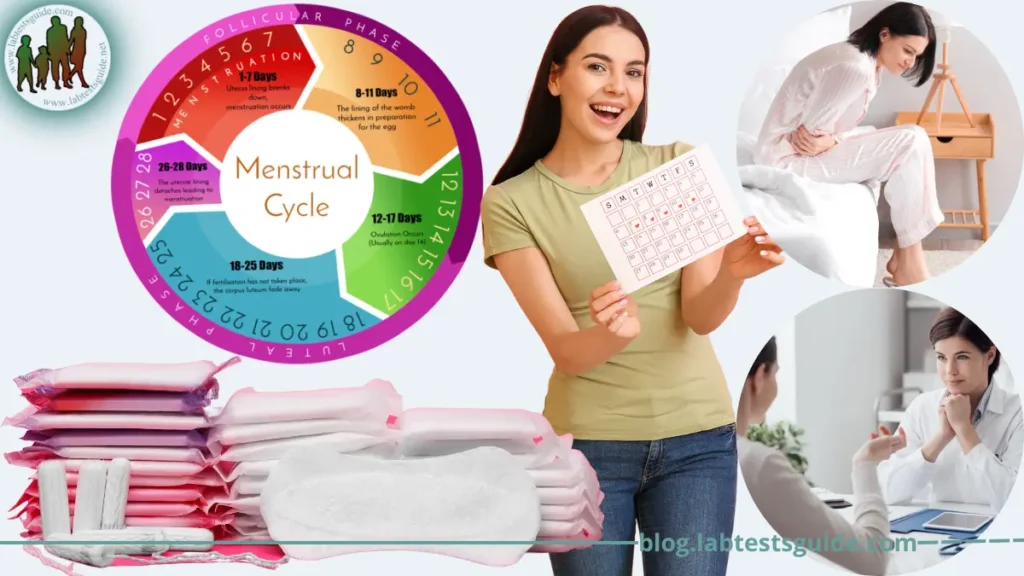Managing menstrual symptoms is an important aspect of a girl’s life as she goes through puberty and experiences menstruation. Menstruation, also known as a period, is a natural process that occurs in females as a part of their reproductive system. However, it can sometimes come with various discomforts and challenges.

This guide aims to provide helpful information and strategies for girls to effectively manage menstrual symptoms. By understanding the menstrual cycle, adopting healthy lifestyle practices, maintaining menstrual hygiene, and utilizing pain management techniques, girls can navigate through their periods with greater ease and comfort.
Additionally, this guide will address specific concerns such as managing heavy flow, dealing with emotional changes, and addressing menstrual irregularities. It is important to remember that every girl’s experience with menstruation is unique, and what works for one person may not work for another. Thus, it is crucial to explore and find the strategies that best suit individual needs.
By empowering girls with knowledge and practical tips, this guide seeks to promote confidence, well-being, and a positive attitude towards menstruation. With the right tools and resources, girls can embrace their menstrual cycle and maintain a healthy and fulfilling lifestyle throughout their menstrual years.
Understanding Menstruation:
What is Menstruation?
- Definition of menstruation
- Purpose of menstruation in the reproductive system
- Onset of menstruation (menarche) and its significance
The Menstrual Cycle
- Explanation of the menstrual cycle
- Phases of the menstrual cycle (follicular, ovulation, luteal, menstruation)
- Hormonal changes during each phase
- Typical duration of the menstrual cycle
Common Menstrual Symptoms:
- Overview of common menstrual symptoms experienced by girls
- Physical symptoms (cramps, bloating, breast tenderness, fatigue, headaches, etc.)
- Emotional and mood-related symptoms (irritability, mood swings, anxiety, etc.)
- Irregularities in menstrual cycle length or flow.
Understanding the basics of menstruation is essential for managing menstrual symptoms effectively. This section provides an overview of what menstruation is, its purpose in the reproductive system, and the significance of menarche (the first occurrence of menstruation). It also explains the menstrual cycle, including its different phases, hormonal changes, and the typical duration of the cycle.
Furthermore, this section explores common menstrual symptoms experienced by girls, both physical and emotional. It covers physical discomforts such as cramps, bloating, breast tenderness, fatigue, and headaches. It also addresses emotional and mood-related symptoms like irritability, mood swings, and anxiety. Additionally, it discusses irregularities in the menstrual cycle length or flow, which can occur from time to time. Understanding these symptoms and their potential causes is crucial for effective symptom management.
Healthy Lifestyle Practices:
Maintaining a healthy lifestyle is key to managing menstrual symptoms and promoting overall well-being. This section focuses on various practices that girls can adopt to support their menstrual health:
Balanced Diet:
- Importance of a balanced diet during menstruation
- Nutrients to focus on (iron, calcium, vitamins, fiber, etc.)
- Foods to incorporate (leafy greens, fruits, whole grains, lean proteins, etc.)
- Limiting caffeine, sugar, and processed foods
Regular Exercise:
- Benefits of exercise for menstrual health
- Types of exercises to consider (aerobic, strength training, yoga, etc.)
- Exercise precautions and modifications during menstruation
- Incorporating physical activity into daily routine
Stress Management:
- The impact of stress on menstrual symptoms
- Stress management techniques (meditation, deep breathing, yoga, etc.)
- Relaxation exercises and practices
- Time management and prioritization
Adequate Sleep:
- The importance of quality sleep for menstrual health
- Establishing a sleep routine
- Creating a comfortable sleep environment
- Strategies for improving sleep quality during menstruation.
Adopting a balanced diet is crucial for providing the body with the necessary nutrients to support menstrual health. This section discusses the importance of a balanced diet during menstruation and highlights specific nutrients to focus on, such as iron, calcium, vitamins, and fiber. It provides guidance on incorporating nutritious foods into the diet and suggests limiting caffeine, sugar, and processed foods, which can potentially worsen menstrual symptoms.
Regular exercise plays a significant role in managing menstrual symptoms. This section emphasizes the benefits of exercise for menstrual health and provides suggestions for different types of exercises to consider. It also addresses exercise precautions and modifications that may be necessary during menstruation.
Stress can impact menstrual symptoms, and this section highlights the importance of stress management techniques. It introduces various relaxation exercises and practices that can help alleviate stress, such as meditation, deep breathing, and yoga. Time management and prioritization strategies are also discussed to promote a balanced and stress-free lifestyle.
Adequate sleep is essential for overall well-being and menstrual health. This section emphasizes the importance of quality sleep and provides tips for establishing a sleep routine and creating a comfortable sleep environment. Strategies for improving sleep quality during menstruation are also included.
By incorporating these healthy lifestyle practices into their daily routine, girls can support their menstrual health and reduce the impact of menstrual symptoms on their well-being.
Menstrual Hygiene:
This section provides guidance on menstrual hygiene practices:
Choosing the Right Menstrual Products:
- Overview of different menstrual products (disposable pads, tampons, menstrual cups, etc.)
- Factors to consider when selecting a menstrual product (comfort, absorbency, convenience, etc.)
- Exploring eco-friendly and sustainable options
- Personal preferences and trial-and-error approach.
Changing and Disposing of Menstrual Products:
- Frequency of changing menstrual products
- Proper techniques for removing and disposing of used products
- Importance of maintaining cleanliness and avoiding infection
- Tips for discreetly managing menstrual products in public settings.
Personal Hygiene Tips:
- Importance of maintaining personal hygiene during menstruation
- Regularly washing hands before and after changing menstrual products
- Proper cleaning of external genitalia
- Considerations for bathing and showering during menstruation
- Addressing common concerns such as odor and vaginal infections.
This section focuses on menstrual hygiene practices to ensure cleanliness, comfort, and infection prevention during menstruation. It provides an overview of different menstrual products available, including disposable pads, tampons, and menstrual cups, and suggests considering factors such as comfort, absorbency, convenience, and personal preferences when choosing a menstrual product. It also encourages exploring eco-friendly and sustainable options.
Proper changing and disposal of menstrual products are crucial for maintaining hygiene. This section offers guidance on the frequency of changing menstrual products, proper techniques for removing and disposing of used products, and emphasizes the importance of cleanliness to prevent infection. It also provides tips for discreetly managing menstrual products in public settings.
Personal hygiene during menstruation is essential, and this section highlights the importance of maintaining cleanliness. It advises regularly washing hands before and after changing menstrual products, proper cleaning of the external genitalia, and considerations for bathing and showering during menstruation. It also addresses common concerns such as managing odor and preventing vaginal infections.
By following proper menstrual hygiene practices, girls can ensure their comfort, minimize the risk of infection, and maintain a sense of cleanliness and well-being during their menstrual cycle.
Pain Management:
Menstrual pain, also known as dysmenorrhea, is a common symptom experienced by many girls during their menstrual cycle. This section focuses on various strategies for managing menstrual pain:
Over-the-Counter Pain Relievers:
- Introduction to over-the-counter pain relievers for menstrual pain (e.g., ibuprofen, acetaminophen)
- Dosage recommendations and precautions
- Timing of medication for maximum effectiveness
- Consulting a healthcare professional for personalized advice
Heat Therapy:
- Benefits of heat therapy for menstrual pain relief
- Different heat therapy options (hot water bottle, heating pad, warm bath, etc.)
- Proper application of heat therapy
- Precautions and safety measures to consider
Relaxation Techniques:
Using relaxation techniques to manage menstrual pain
Deep breathing exercises
Progressive muscle relaxation
Guided imagery and visualization
Yoga and gentle stretching exercises.
Herbal Remedies:
- Overview of herbal remedies for menstrual pain relief (e.g., ginger, chamomile, turmeric)
- Precautions and potential interactions with other medications
- Consulting a healthcare professional before using herbal remedies
This section provides options for managing menstrual pain effectively. It introduces over-the-counter pain relievers that can help alleviate menstrual cramps and provides dosage recommendations and precautions. It emphasizes the importance of timing medication for maximum effectiveness and suggests consulting a healthcare professional for personalized advice.
Heat therapy is another useful strategy for managing menstrual pain, and this section explores its benefits. It discusses various heat therapy options such as hot water bottles, heating pads, and warm baths and provides guidance on their proper application. It also highlights important precautions and safety measures to ensure safe and effective use.
Relaxation techniques can be beneficial for managing menstrual pain and promoting overall well-being. This section introduces relaxation techniques such as deep breathing exercises, progressive muscle relaxation, guided imagery, and yoga and gentle stretching exercises. These techniques can help relax the body and reduce pain and discomfort during menstruation.
Herbal remedies are often sought for menstrual pain relief, and this section provides an overview of some commonly used herbs such as ginger, chamomile, and turmeric. It advises caution regarding potential interactions with other medications and recommends consulting a healthcare professional before using herbal remedies.
By utilizing these pain management strategies, girls can effectively alleviate menstrual pain and improve their overall comfort during their menstrual cycle. It is important to remember that individual responses to pain management techniques may vary, and it may be necessary to explore and find the methods that work best for each individual.
Managing Heavy Flow:
Some girls may experience heavy menstrual flow, which can be challenging to manage. This section focuses on strategies to effectively manage heavy flow.
Using High-Absorbency Menstrual Products:
- Introduction to high-absorbency menstrual products (pads, tampons, menstrual cups)
- Choosing the right absorbency level for heavy flow
- Changing menstrual products regularly to prevent leakage
- Exploring alternative options for better management (e.g., menstrual discs).
Tracking and Planning Ahead:
- Tracking menstrual flow patterns and identifying heavy flow days
- Utilizing period tracking apps or calendars
- Planning for heavier days by carrying extra menstrual products
- Being prepared for unexpected changes in flow
Dietary Considerations:
- Including iron-rich foods in the diet to prevent anemia
- Consuming foods that may help regulate menstrual flow (e.g., pineapple, ginger)
- Staying hydrated to support overall menstrual health
- Discussing dietary concerns with a healthcare professional if necessary.
Managing heavy flow requires attention to the right menstrual products and planning ahead. This section highlights the use of high-absorbency menstrual products, such as pads, tampons, and menstrual cups, and encourages choosing the right absorbency level for heavy flow. It emphasizes the importance of changing menstrual products regularly to prevent leakage and suggests exploring alternative options, such as menstrual discs, for better management.
Tracking and planning ahead can help girls anticipate heavy flow days and be prepared. This section suggests tracking menstrual flow patterns using period tracking apps or calendars to identify heavy flow days. It advises carrying extra menstrual products during those days and being prepared for unexpected changes in flow.
Dietary considerations can also play a role in managing heavy flow. This section recommends including iron-rich foods in the diet to prevent anemia, as heavy flow can lead to increased blood loss. It suggests consuming foods that may help regulate menstrual flow, such as pineapple and ginger. Staying hydrated is also important for supporting overall menstrual health. If there are specific dietary concerns or questions, it is advisable to discuss them with a healthcare professional.
By utilizing these strategies, girls can effectively manage heavy flow and minimize any discomfort or inconvenience associated with it. It is important to remember that heavy flow can vary from person to person, and individual experiences may require personalized approaches to manage it effectively.
Dealing with Emotional Changes:
This section focuses on strategies to effectively manage and cope with emotional changes.
Self-Care Practices:
- Prioritizing self-care during the menstrual cycle
- Engaging in activities that promote relaxation and well-being (e.g., taking a bath, practicing mindfulness, journaling)
- Creating a supportive and comforting environment for oneself
- Practicing self-compassion and self-acceptance.
Talking to Friends or Family:
- Sharing experiences and emotions with trusted friends or family members
- Seeking understanding and empathy
- Discussing concerns and seeking advice if needed
- Building a support network for emotional support during menstruation.
Seeking Professional Help:
- Recognizing when emotional changes significantly impact daily life and well-being
- Considering professional help, such as therapy or counseling
- Consulting a healthcare provider for guidance and recommendations
- Exploring therapeutic techniques for managing emotional symptoms (e.g., cognitive-behavioral therapy).
Managing emotional changes during the menstrual cycle involves self-care practices that prioritize relaxation and well-being. This section encourages engaging in activities that promote self-care, such as taking a bath, practicing mindfulness, and journaling. Creating a supportive and comforting environment for oneself and practicing self-compassion and self-acceptance can also be beneficial.
Talking to trusted friends or family members about emotional experiences can provide understanding and empathy. This section suggests sharing emotions, discussing concerns, and seeking advice when needed. Building a support network of individuals who can provide emotional support during menstruation can be invaluable.
In cases where emotional changes significantly impact daily life and well-being, seeking professional help may be necessary. This section highlights the importance of recognizing when emotional changes require professional intervention. It suggests considering therapy or counseling and consulting a healthcare provider for guidance and recommendations. Therapeutic techniques, such as cognitive-behavioral therapy, may be explored to manage emotional symptoms effectively.
By implementing these strategies, girls can better cope with emotional changes during the menstrual cycle and maintain their emotional well-being. It is essential to remember that everyone’s emotional experiences during menstruation can vary, and finding the approaches that work best for individual needs and seeking professional help when necessary is important.
Managing Menstrual Irregularities:
This section focuses on strategies to manage and address menstrual irregularities:
Tracking and Monitoring:
- Keeping track of menstrual cycles using a period tracker app or calendar
- Noting any changes in cycle length or flow
- Identifying potential triggers or patterns associated with irregularities
- Seeking medical attention if irregularities persist or cause concern
Healthy Lifestyle Practices:
- Maintaining a balanced diet and regular exercise routine
- Managing stress levels through relaxation techniques and stress management strategies
- Getting enough sleep and rest
- Taking care of overall physical and mental well-being.
Consulting a Healthcare Professional:
- Seeking medical advice for persistent or concerning irregularities
- Providing detailed information about irregularities and any associated symptoms
- Undergoing necessary medical examinations or tests to identify underlying causes
- Exploring treatment options or interventions as recommended by the healthcare professional
- Managing menstrual irregularities involves actively tracking and monitoring menstrual cycles.
This section suggests using a period tracker app or calendar to keep track of cycle length and flow. Noting any changes and identifying potential triggers or patterns associated with irregularities can help in managing them effectively. If irregularities persist or cause concern, seeking medical attention is important.
Adopting healthy lifestyle practices can contribute to maintaining regular menstrual cycles. This section emphasizes the importance of a balanced diet, regular exercise, stress management, and adequate sleep. Taking care of overall physical and mental well-being can help regulate menstrual cycles.
When dealing with persistent or concerning irregularities, it is advisable to consult a healthcare professional. This section highlights the importance of seeking medical advice and provides guidance on providing detailed information about irregularities and any associated symptoms. The healthcare professional may conduct necessary examinations or tests to identify underlying causes and recommend appropriate treatment options or interventions.
By actively tracking menstrual cycles, maintaining a healthy lifestyle, and seeking professional guidance when needed, girls can effectively manage and address menstrual irregularities. It is important to remember that menstrual irregularities can have various causes, and personalized medical advice is crucial for accurate diagnosis and treatment.
Conclusion:
Managing menstrual symptoms as a girl involves understanding menstruation, adopting healthy lifestyle practices, maintaining menstrual hygiene, addressing pain management, dealing with emotional changes, and managing menstrual irregularities. By implementing these strategies, girls can support their menstrual health, alleviate discomfort, and improve overall well-being during their menstrual cycle.
Understanding menstruation is essential for girls to navigate this natural process. It involves learning about the menstrual cycle, hormonal changes, and common symptoms. This knowledge helps girls prepare and manage their menstrual experience effectively.
Adopting healthy lifestyle practices, such as maintaining a balanced diet, regular exercise routine, stress management techniques, and adequate sleep, supports menstrual health. These practices promote overall well-being and can alleviate menstrual symptoms.
Maintaining menstrual hygiene is crucial for comfort and preventing infections. Choosing the right menstrual products, changing them regularly, and practicing proper personal hygiene help girls feel clean and confident during their menstrual cycle.
Pain management strategies, such as using over-the-counter pain relievers, heat therapy, relaxation techniques, and herbal remedies, can help alleviate menstrual cramps and discomfort. Girls can explore these options to find what works best for them.
Emotional changes during the menstrual cycle are common. Engaging in self-care practices, talking to friends or family, and seeking professional help when needed can support emotional well-being during menstruation.
Menstrual irregularities may occur from time to time, and tracking cycles, maintaining a healthy lifestyle, and consulting healthcare professionals are important for managing and addressing them effectively. Seeking medical advice and necessary examinations or tests can help identify underlying causes and guide appropriate treatment.
By combining knowledge, self-care practices, and seeking professional guidance when necessary, girls can manage menstrual symptoms, promote their well-being, and navigate their menstrual cycle with confidence and comfort. It is important for girls to remember that each person’s menstrual experience is unique, and finding individualized approaches that work best for them is crucial.






